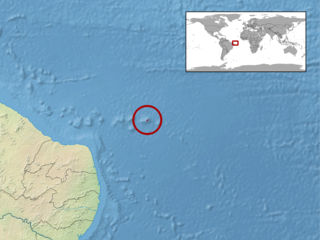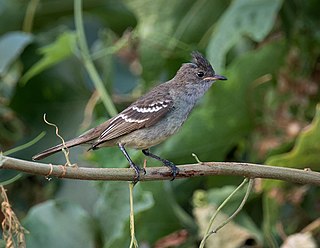 W
WFernando de Noronha is an archipelago in the Atlantic Ocean, part of the State of Pernambuco, Brazil, and located 354 km (220 mi) offshore from the Brazilian coast. It consists of 21 islands and islets, extending over an area of 26 km2 (10 sq mi). Only the homonymous main island is inhabited; it has an area of 18.4 km2 (7.1 sq mi) and a population estimated at 2,718 in 2012.
 W
WAmphisbaena ridleyi, known by the common names Ridley's worm lizard or the Noronha worm lizard, is a species of amphisbaenian in the family Amphisbaenidae. The species is endemic to the island of Fernando de Noronha off the coast of Brazil. It is one of two indigenous reptiles on the island.
 W
WThe Noronha elaenia is a species of bird in the tyrant-flycatcher family Tyrannidae. It is endemic to Fernando de Noronha, a small archipelago off the coast of Brazil. The species was formerly considered a subspecies of the large elaenia, but differs considerably in the calls and song.
 W
WFicus cyclophylla is a species of fig tree in the family Moraceae, native to Brazil.
 W
WThe Noronha skink is a species of skink from the island of Fernando de Noronha off northeastern Brazil. It is covered with dark and light spots on the upperparts and is usually about 7 to 10 cm in length. The tail is long and muscular, but breaks off easily. Very common throughout Fernando de Noronha, it is an opportunistic feeder, eating both insects and plant material, including nectar from the Erythrina velutina tree, as well as other material ranging from cookie crumbs to eggs of its own species. Introduced predators such as feral cats prey on it and several parasitic worms infect it.
 W
WNoronhomys vespuccii, also known as Vespucci's rodent, is an extinct rat species from the islands of Fernando de Noronha off northeastern Brazil. Italian explorer Amerigo Vespucci may have seen it on a visit to Fernando de Noronha in 1503, but it subsequently became extinct, perhaps because of the exotic rats and mice introduced by the first explorers of the island. Numerous but fragmentary fossil remains of the animal, of uncertain but probably Holocene age, were discovered in 1973 and described in 1999.
 W
WThe Noronha vireo is a species of bird in the family Vireonidae. It is endemic to the island of Fernando de Noronha, Brazil. It is found in woodland, shrubland and gardens. It has been considered conspecific with the chivi vireo in the past. However, it varies from the chivi vireo in that its plumage is significantly duller and the bill longer.